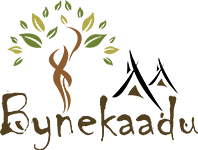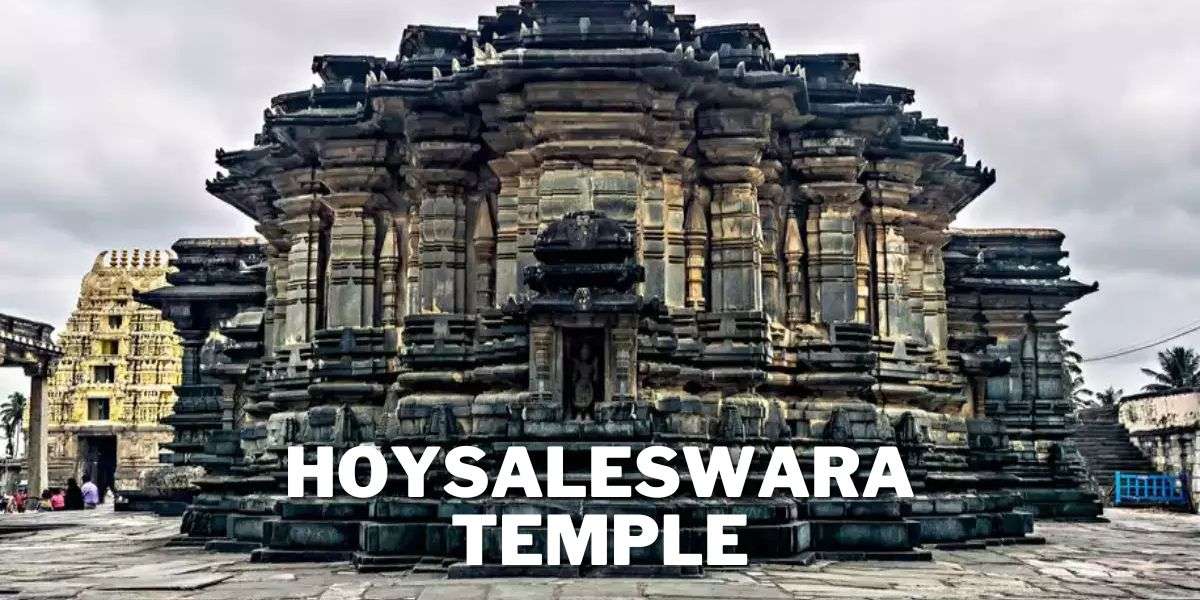Discover the intricate beauty and profound spiritual significance of Hoysaleswara Temple, a gem of Indian architecture in the quaint town of Halebidu. This 12th-century marvel is a testament to the architectural brilliance and cultural richness of the Hoysala Dynasty. Known for its exquisite carvings and detailed sculptures, the Hoysaleswara Temple offers a profound spiritual experience, a glimpse into the artistry and devotion of an era gone by. Join us as we explore this iconic temple’s history, architecture, and significance, providing a comprehensive guide to plan your visit and immerse yourself in its timeless charm.
Historical Background
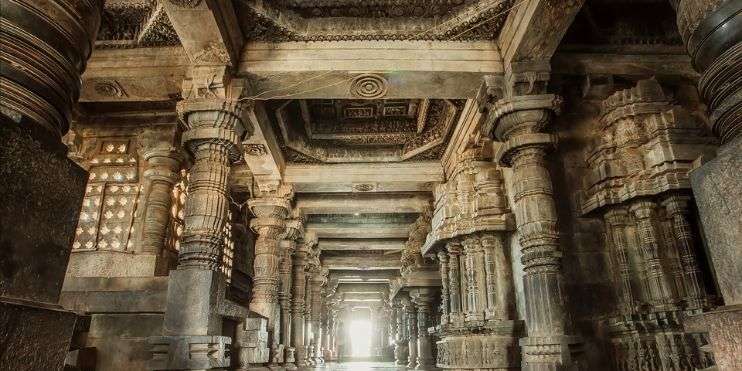
The Hoysala Dynasty
The Hoysala Empire flourished between the 10th and 14th centuries and is renowned for its contributions to art, culture, and architecture in South India. Under the Hoysalas’ rule, the region witnessed a golden age of temple construction, with the Hoysaleswara Temple being one of the most prominent examples of their architectural prowess.
Construction of Hoysaleswara Temple
Commissioned by King Vishnuvardhana in the early 12th century, the Hoysaleswara Temple was built in dedication to Lord Shiva. The construction of this grand temple was heavily influenced by Queen Shantala Devi, whose devotion to art and religion played an essential role in its creation. The temple’s intricate carvings and detailed sculptures reflect the craftsmanship and dedication of the artisans who worked on it for over a century.
Significance in History
Throughout history, the Hoysaleswara Temple has been a center of religious and cultural activities. It played a crucial role in the spiritual life of the Hoysala Empire, hosting numerous festivals and ceremonies. However, the temple faced challenges, including invasions that partially destroyed it. Despite these adversities, the temple has stood the test of time, continuing to symbolize the region’s rich heritage.
Architectural Marvel Of Hoysaleswara Temple
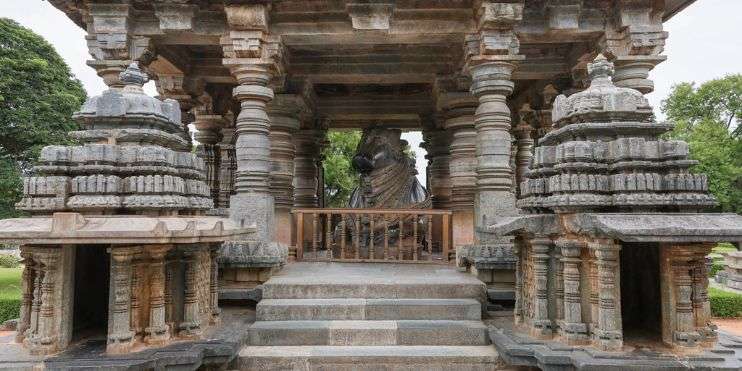
Dravidian Architecture
The Hoysaleswara Temple is a prime example of Dravidian architecture, characterized by its intricate sculptures, detailed carvings, and majestic structure. This architectural masterpiece, prevalent in South India, is known for its pyramid-shaped towers, elaborate pillared halls, and intricate stonework, a true delight for architecture enthusiasts.
Sculptural Details
One of the most striking features of the Hoysaleswara Temple is its detailed sculptures. The temple walls are adorned with thousands of carvings depicting scenes from Hindu mythology, everyday life, and nature. Notable sculptures depict deities such as Shiva, Vishnu, and Durga, as well as intricate depictions of animals, dancers, and musicians.
Temple Layout
The Hoysaleswara Temple complex features a unique layout with twin sanctums dedicated to Shiva, known as Hoysaleswara and Shantaleswara. The temple’s symmetrical design and interconnected halls showcase the architectural ingenuity of the period. The central hall, or mandapa, is supported by intricately carved pillars, each telling its own story.
Architects and Artisans
The construction of the Hoysaleswara Temple involved the expertise of numerous skilled architects and artisans. These craftsmen employed advanced techniques and high-quality materials, including chloritic schist (soapstone), allowing detailed carvings. The artistry and dedication of these individuals are evident in every corner of the temple.
Hoysaleswara Temple Cultural and Religious Significance
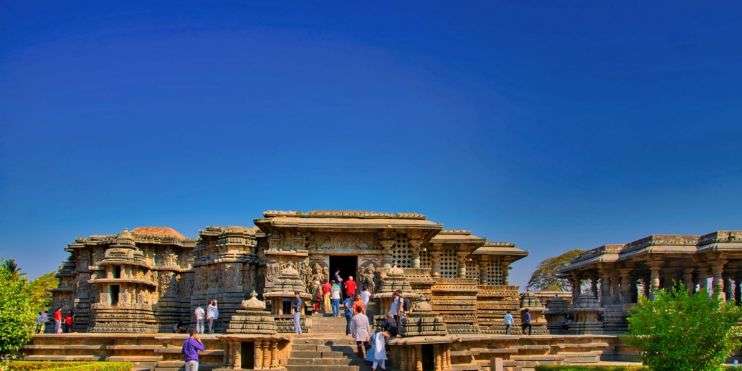
Role in Hindu Worship
The Hoysaleswara Temple holds immense significance in Hindu worship, particularly for devotees of Lord Shiva. The temple serves as a sacred space for rituals, prayers, and ceremonies dedicated to Shiva, attracting pilgrims and tourists alike.
Festivals and Celebrations
Major festivals like Maha Shivaratri are enthusiastically celebrated at the Hoysaleswara Temple. These festivals draw large crowds and offer a glance into the region’s rich cultural traditions. The temple complex comes alive during these celebrations with music, dance, and religious rituals.
Hoysaleswara Temple Symbolism and Iconography
![]()
One aspect of the Hoysaleswara Temple that often captivates visitors is the deep symbolism and intricate iconography found throughout the temple complex. The carvings and sculptures are not just decorative; they carry profound symbolic meanings that reflect the spiritual and cultural ethos of the time.
Hoysaleswara Temple Symbolism in Sculptures
The temple’s sculptures depict various themes, including religious narratives, mythological scenes, and representations of daily life. For example, depicting different forms of Shiva, such as Nataraja (the cosmic dancer), emphasizes the deity’s multifaceted nature. The presence of mythical creatures, such as makaras (crocodile-like creatures), and the intricate floral and geometric patterns symbolize cosmic harmony and the interconnectedness of life.
The Iconography of Deities Hoysaleswara Temple
The iconography of the deities at Hoysaleswara Temple is meticulously detailed. Each figure is adorned with specific attributes and symbols that convey their divine qualities and roles. For instance, the depiction of Vishnu with his traditional attributes, such as the conch (shankha) and discus (chakra), illustrates his role as the preserver of the universe. Similarly, the goddess Durga is shown triumphantly slaying the buffalo demon Mahishasura, symbolizing the victory of good over evil.
Narrative Panels Of Hoysaleswara Temple
The temple’s walls are adorned with narrative panels and visual scriptures recounting stories from the Mahabharata, Ramayana, and other Puranic texts. These panels act as a rich source of education, imparting moral and ethical lessons embedded in these epic tales. The detailed portrayal of these stories offers a window into the cultural and religious context of the Hoysala period.
Hoysaleswara Temple Symbolic Motifs
The temple’s design is replete with recurring motifs, each carrying its symbolic weight. The lotus flower, for instance, symbolizes purity and divine beauty, while the kalasha (pot of abundance) motifs represent prosperity and the fulfillment of wishes. These symbolic elements not only enhance the spiritual ambiance of the temple but also invite devotees and visitors to delve into their deeper meanings.
Hoysaleswara Temple Visiting Time
The Hoysaleswara Temple is open to visitors from 6:30 AM – 9:00 PM daily. Visiting early in the morning or late in the afternoon is advisable to avoid the midday heat and crowds.
Best Time to Visit Hoysaleswara Temple
The best time to visit this temple is in February for the festival of Shivratri; February is an excellent time to see as the temple celebrates the festival of Maha Shivaratri. This grand festival dedicated to Lord Shiva is marked by vibrant rituals, music, and dance, providing visitors with a unique cultural experience that adds to the charm of the temple visit.
Entry Fee Hoysaleswara Temple
Appreciating the historical and architectural beauty of the Hoysaleswara Temple, accessible to all, with no entry fee for Indian visitors. This inclusivity allows everyone to experience the temple’s grandeur. However, foreign tourists may be required to pay a nominal fee.
How to Reach Hoysaleswara Temple
Hoysaleswara Temple is well-connected by road, and there are several transportation options available:
- By Air: The nearest airport is Mangalore, approximately 168 km away.
- By Train: The nearest railway station is in Hassan, about 31 km from Halebidu.
- By Road: Halebidu is easily accessible from major cities like Bangalore (220 km) and Chikmagalur (33 km). Routine bus services and private cabs are available.
Facilities for Tourists
The temple complex offers amenities such as guided tours, parking facilities, and nearby accommodations. Regional guides can give in-depth details about the temple’s history and architecture.
Photography Tips
For photography enthusiasts, the best time to capture the temple’s beauty is during the golden hours of sunrise and sunset. The soft lighting during these times enhances the intricate details of the carvings. Take advantage of the opportunity to photograph the temple’s exquisite sculptures and the serene surroundings.
Things to Do at Hoysaleswara Temple
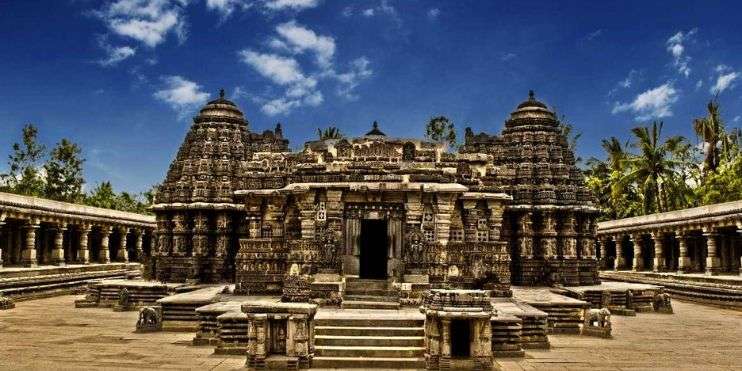
Explore the Intricate Carvings
Take your time to walk around the temple complex and marvel at the detailed carvings on the temple walls. Each sculpture tells a unique story, offering an in-depth plunge into the prosperous tapestry of Hindu mythology and daily life in ancient times.
Participate in Rituals
If you visit during a festival or special occasion, immerse yourself in the unique cultural experience of participating in the rituals and ceremonies held at the temple. This provides a deeper understanding of the local religious practices and a fascinating glimpse into the region’s rich history.
Join a Guided Tour
Engage a local guide to take you through the temple complex. A guided tour will provide insightful information about various sculptures and carvings’ history, architecture, and significance.
Attend a Festival
Visit significant festivals like Maha Shivaratri to witness the temple’s glory. The vibrant festivities, coupled with the backdrop of the ancient temple, create an unforgettable experience.
Relax in the Temple Gardens
The temple complex includes beautifully maintained gardens where tourists can rest and soak in the peaceful atmosphere. It’s an ideal spot for a quiet break after exploring the temple.
Nearby Attractions and Activities
Belur Chennakeshava Temple

Just 17 Km from Halebidu lies the equally magnificent Chennakeshava Temple in Belur. This temple, also built by the Hoysalas, showcases similar architectural brilliance with its elaborate carvings and sculptures. A visit to both temples offers a comprehensive understanding of Hoysala architecture.
Shravanabelagola

Another notable site nearly 80 km from Halebidu is Shravanabelagola, a significant pilgrimage destination for Jains. The towering statue of Gomateshwara Bahubali is a major attraction, and the site offers a serene and spiritual experience.
Yagachi Dam and Reservoir
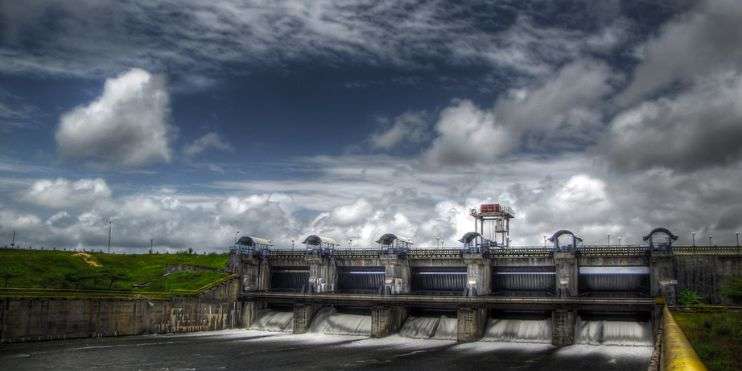
For those seeking a bit of nature and recreation, the Yagachi Dam and Reservoir near Belur provide a perfect getaway. Visitors can enjoy boating, picnics, and the scenic beauty of the reservoir, making it a great addition to the Halebidu visit.
Local Cuisine and Markets

Every trip is complete with indulging in the local cuisine. Halebidu tastes traditional Karnataka dishes like Bisi Bele Bath, Mysore Pak, and local thalis. Additionally, the regional markets offer a variety of souvenirs, including handicrafts and traditional artifacts, perfect for taking a piece of Karnataka back home.
Bynekaadu: A Tranquil Retreat Near Hoysaleswara Temple
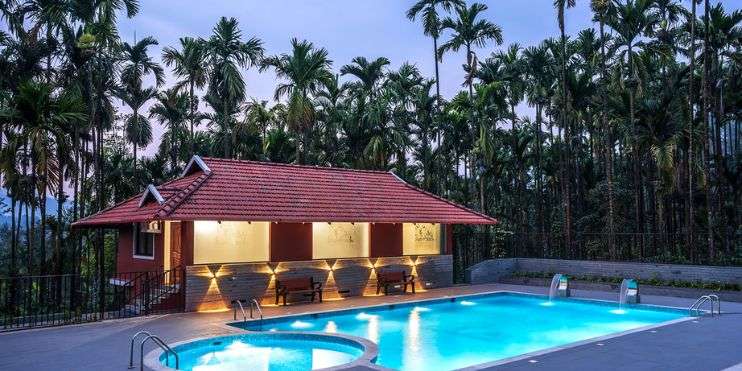
When visiting the magnificent Hoysaleswara Temple, extend your journey to the serene haven of Bynekaadu, our exclusive resort nestled in the lush greenery of Karnataka. Bynekaadu offers a perfect blend of luxury and nature, providing an ideal retreat after exploring the historical wonders of Halebidu.
At Bynekaadu, you can unwind in our comfortable cottages, which offer dazzling views of the surrounding forests and hills. Our resort is designed to provide a peaceful escape, with amenities such as a tranquil swimming pool, guided nature walks, and delicious local cuisine prepared with fresh, organic ingredients.
Our proximity to the Hoysaleswara Temple makes Bynekaadu an ideal base for your cultural exploration. Returning to our resort to relax and rejuvenate after immersing yourself in the temple’s architectural grandeur. Whether you want to meditate amidst nature, enjoy a quiet evening by the bonfire, or explore the nearby coffee plantations, Bynekaadu has something for everyone.
Conclusion
The Hoysaleswara Temple in Halebidu is not just a monument but a living testament to the artistic and cultural grandeur of the Hoysala Empire. Its intricate carvings, historical significance, and spiritual aura make it a must-visit destination for history lovers, architecture lovers, and spiritual seekers alike. As you plan your visit, take a moment to explore the nearby attractions and engage yourself in the rich heritage of Karnataka. Let the Hoysaleswara Temple be a doorway to the past, offering insights into the craftsmanship and devotion of a bygone era. Make your visit to Halebidu genuinely memorable by staying with us at Bynekaadu. Contact us today to book your stay and experience the perfect blend of history, culture, and tranquility.
